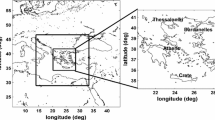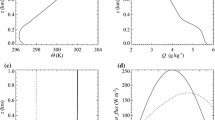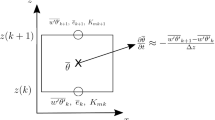Abstract
Five planetary-boundary-layer parametrizations of the Weather Research and Forecasting model are compared with respect to their ability to simulate the very stable and the weakly stable regimes of the stable boundary layer. This is performed for single column models where the large-scale mechanical forcing is represented by geostrophic wind speeds ranging from 0.5 to 12 m \(\hbox {s}^{-1}\). The performance of the models is assessed by contrasting the relationships they produce between the turbulence velocity scale and the mean wind speed, between potential temperature gradient and the mean wind speed, and between the flux and gradient Richardson numbers. The level-2.5 Mellor–Yamada–Nakanishi–Niino parametrization simulates the very stable regime the best, mainly because its heat eddy diffusivity decreases with respect to the momentum eddy diffusivity as the stability increases, while the same is not true for the other parametrizations considered.










Similar content being viewed by others
References
Acevedo OC, Costa FD, Degrazia GA (2012) The coupling state of an idealized stable boundary layer. Boundary-Layer Meteorol 145(1):211–228
Acevedo OC, Mahrt L, Puhales FS, Costa FD, Medeiros LE, Degrazia GA (2016) Contrasting structures between the decoupled and coupled states of the stable boundary layer. Q J R Meteorol Soc 142(695):693–702. https://doi.org/10.1002/qj.2693
Acevedo OC, Maroneze R, Costa FD, Puhales FS, Degrazia GA, Nogueira Martins LG, Soares de Oliveira PE, Mortarini L (2019) The nocturnal boundary layer transition from weakly to very stable. Part I: Observations. Q J R Meteorol Soc 145(725):3577–3592. https://doi.org/10.1002/qj.3642
André JC, Mahrt L (1982) The nocturnal surface inversion and influence of clear-air radiative cooling. J Atmos Sci 39(4):864–878
Baas P, van de Wiel BJ, van Meijgaard E, Vignon E, Genthon C, van der Linden SJ, de Roode SR (2019) Transitions in the wintertime near-surface temperature inversion at Dome C, Antarctica. Q J R Meteorol Soc 145(720):930–946
Battisti A, Acevedo OC, Costa FD, Puhales FS, Anabor V, Degrazia GA (2017) Evaluation of nocturnal temperature forecasts provided by the Weather Research and Forecast model for different stability regimes and terrain characteristics. Boundary-Layer Meteorol 162(3):523–546
Bou-Zeid E, Gao X, Ansorge C, Katul GG (2018) On the role of return to isotropy in wall-bounded turbulent flows with buoyancy. J Fluid Mech 856:61–78
Bougeault P, Lacarrere P (1989) Parameterization of orography-induced turbulence in a mesobeta-scale model. Mon Wea Rev 117(8):1872–1890
Bretherton CS, Park S (2009) A new moist turbulence parameterization in the community atmosphere model. J Clim 22(12):3422–3448. https://doi.org/10.1175/2008JCLI2556.1
Canuto VM, Cheng Y, Howard AM, Esau IN (2008) Stably stratified flows: a model with no Ri(cr). J Atmos Sci 65(7):2437–2447. https://doi.org/10.1175/2007JAS2470.1
Chen SH, Sun WY (2002) A one-dimensional time dependent cloud model. J Met Soc Japan 80(1):99–118. https://doi.org/10.2151/jmsj.80.99
Cheng Y, Brutsaert W (2005) Flux-profile relationships for wind speed and temperature in the stable atmospheric boundary layer. Boundary-Layer Meteorol 114(3):519–538
Costa FD, Acevedo OC, Mombach JC, Degrazia GA (2011) A simplified model for intermittent turbulence in the nocturnal boundary layer. J Atmos Sci 68(8):1714–1729
Costa FD, Acevedo OC, Medeiros LE, Maroneze R, Puhales FS, Carvalho AD Jr, Camponogara LF, dos Santos DM, Mortarini L (2020) Stable boundary layer regimes in single-column models. J Atmos Sci 77(6):2039–2054. https://doi.org/10.1175/JAS-D-19-0218.1
Cuxart J, Holtslag AAM, Beare RJ, Bazile E, Beljaars A, Cheng A, Conangla L, Ek M, Freedman F, Hamdi R, Kerstein A, Kitagawa H, Lenderink G, Lewellen D, Mailhot J, Mauritsen T, Perov V, Schayes G, Steeneveld GJ, Svensson G, Taylor P, Weng W, Wunsch S, Xu KM (2006) Single-column model intercomparison for a stably stratified atmospheric boundary layer. Boundary-Layer Meteorol 118(2):273–303
Dias-Júnior CQ, Sá LD, Marques Filho EP, Santana RA, Mauder M, Manzi AO (2017) Turbulence regimes in the stable boundary layer above and within the Amazon Forest. Agric For Meteorol 233:122–132
Dimitrova R, Silver Z, Zsedrovits T, Hocut CM, Leo LS, Di Sabatino S, Fernando HJS (2016) Assessment of planetary boundary-layer schemes in the Weather Research and Forecasting mesoscale model using MATERHORN field data. Boundary-Layer Meteorol 159(3):589–609. https://doi.org/10.1007/s10546-015-0095-8
Dudhia J (1989) Numerical study of convection observed during the winter monsoon experiment using a mesoscale two-dimensional model. J Atmos Sci 46(20):3077–3107
Holdsworth AM, Monahan AH (2019) Turbulent collapse and recovery in the stable boundary layer using an idealized model of pressure-driven flow with a surface energy budget. J Atmos Sci 76(5):1307–1327
Janjić ZI (1994) The step-mountain Eta coordinate model: Further developments of the convection, viscous sublayer, and turbulence closure schemes. Mon Wea Rev 122(5):927–945
Janjić ZI (2002) Nonsingular implementation of the Mellor-Yamada level 2.5 scheme in the NCEP meso model. https://repository.library.noaa.gov/view/noaa/11409
Jiménez PA, Dudhia J, González-Rouco JF, Navarro J, Montávez JP, García-Bustamante E (2012) A revised scheme for the WRF surface layer formulation. Mon Wea Rev 140(3):898–918
Katul GG, Porporato A, Shah S, Bou-Zeid E (2014) Two phenomenological constants explain similarity laws in stably stratified turbulence. Phys Rev E 89(023):007. https://doi.org/10.1103/PhysRevE.89.023007
Kitamura Y (2010) Modifications to the Mellor-Yamada-Nakanishi-Niino (MYNN) model for the stable stratification case. J Met Soc Japan 88(5):857–864
Klein PM, Hu XM, Shapiro A, Xue M (2016) Linkages between boundary-layer structure and the development of nocturnal low-level jets in Central Oklahoma. Boundary-Layer Meteorol 158(3):383–408
Lan C, Liu H, Li D, Katul GG, Finn D (2018) Distinct turbulence structures in stably stratified boundary layers with weak and strong surface shear. J Geophys Res 123(15):7839–7854
Lapo K, Nijssen B, Lundquist JD (2019) Evaluation of turbulence stability schemes of land models for stable conditions. J Geophys Res 124(6):3072–3089. https://doi.org/10.1029/2018JD028970
Mahrt L (1998) Nocturnal boundary-layer regimes. Boundary-Layer Meteorol 88(2):255–278. https://doi.org/10.1023/A:1001171313493
Mahrt L (2009) Characteristics of submeso winds in the stable boundary layer. Boundary-Layer Meteorol 130(1):1–14
Mahrt L (2010) Variability and maintenance of turbulence in the very stable boundary layer. Boundary-Layer Meteorol 135(1):1–18
Mahrt L (2014) Stably stratified atmospheric boundary layers. Ann Rev Fluid Mech 46(1):23–45. https://doi.org/10.1146/annurev-fluid-010313-141354
Mahrt L, Gamage N (1987) Observations of turbulence in stratified flow. J Atmos Sci 44(7):1106–1121
Maroneze R, Acevedo OC, Costa FD, Puhales FS, Demarco G, Mortarini L (2019a) The nocturnal boundary layer transition from weakly to very stable. Part II: Numerical simulation with a second-order model. Q J R Meteorol Soc 145(725):3593–3608. https://doi.org/10.1002/qj.3643
Maroneze R, Acevedo OC, Costa FD, Sun J (2019b) Simulating the regime transition of the stable boundary layer using different simplified models. Boundary-Layer Meteorol 170(2):305–321. https://doi.org/10.1007/s10546-018-0401-3
McNider RT, England DE, Friedman MJ, Shi X (1995) Predictability of the stable atmospheric boundary layer. J Atmos Sci 52(10):1602–1614
Mellor GL, Yamada T (1974) A hierarchy of turbulence closure models for planetary boundary layers. J Atmos Sci 31(7):1791–1806
Mellor GL, Yamada T (1982) Development of a turbulence closure model for geophysical fluid problems. Rev Geophys 20(4):851–875
Mlawer EJ, Taubman SJ, Brown PD, Iacono MJ, Clough SA (1997) Radiative transfer for inhomogeneous atmospheres: RRTM, a validated correlated-k model for the longwave. J Geophys Res 102(D14):16,663–16,682. https://doi.org/10.1029/97JD00237
Monahan AH, Rees T, He Y, McFarlane N (2015) Multiple regimes of wind, stratification, and turbulence in the stable boundary layer. J Atmos Sci 72(8):3178–3198. https://doi.org/10.1175/JAS-D-14-0311.1
Mukul Tewari N, Tewari M, Chen F, Wang W, Dudhia J, LeMone M, Mitchell K, Ek M, Gayno G, Wegiel J et al (2004) Implementation and verification of the unified NOAH land surface model in the WRF model (formerly paper number 17.5). In: 20th conference on weather analysis and forecasting/16th conference on numerical weather prediction, pp 11–15
Nakanishi M (2001) Improvement of the Mellor–Yamada turbulence closure model based on large-eddy simulation data. Boundary-Layer Meteorol 99(3):349–378. https://doi.org/10.1023/A:1018915827400
Nakanishi M, Niino H (2006) An improved Mellor–Yamada level-3 model: its numerical stability and application to a regional prediction of advection fog. Boundary-Layer Meteorol 119(2):397–407. https://doi.org/10.1007/s10546-005-9030-8
Nakanishi M, Niino H (2009) Development of an improved turbulence closure model for the atmospheric boundary layer. J Met Soc Japan 87(5):895–912. https://doi.org/10.2151/jmsj.87.895
Ohya Y (2001) Wind-tunnel study of atmospheric stable boundary layers over a rough surface. Boundary-Layer Meteorol 98(1):57–82. https://doi.org/10.1023/A:1018767829067
Olson JB, Kenyon JS, Angevine W, Brown JM, Pagowski M, Sušelj K et al (2019) A description of the MYNN-EDMF scheme and the coupling to other components in WRF–ARW. https://repository.library.noaa.gov/view/noaa/19837
Pardyjak ER, Monti P, Fernando HJS (2002) Flux Richardson number measurements in stable atmospheric shear flows. J Fluid Mech 459:307–316. https://doi.org/10.1017/S0022112002008406
Poulos GS, Blumen W, Fritts DC, Lundquist JK, Sun J, Burns SP, Nappo C, Banta R, Newsom R, Cuxart J, Terradellas E, Balsley B, Jensen M (2002) CASES-99: a comprehensive investigation of the stable nocturnal boundary layer. Bull Am Meteorol Soc 83(4):555–582
Powers JG, Klemp JB, Skamarock WC, Davis CA, Dudhia J, Gill DO, Coen JL, Gochis DJ, Ahmadov R, Peckham SE, Grell GA, Michalakes J, Trahan S, Benjamin SG, Alexander CR, Dimego GJ, Wang W, Schwartz CS, Romine GS, Liu Z, Snyder C, Chen F, Barlage MJ, Yu W, Duda MG (2017) The weather research and forecasting model: overview, system efforts, and future directions. Bull Am Meteorol Soc 98(8):1717–1737
Skamarock WC, Klemp JB, Dudhia J, Gill DO, Barker DM, Wang W, Powers JG (2008) A description of the advanced research WRF version 3. NCAR technical note-475+ STR. https://opensky.ucar.edu/islandora/object/technotes:500
Steeneveld GJ, van de Wiel BJH, Holtslag AAM (2006) Modeling the evolution of the atmospheric boundary layer coupled to the land surface for three contrasting nights in CASES-99. J Atmos Sci 63(3):920–935. https://doi.org/10.1175/JAS3654.1
Sukoriansky S, Galperin B, Perov V (2005) Application of a new spectral theory of stably stratified turbulence to the atmospheric boundary layer over sea ice. Boundary-Layer Meteorol 117(2):231–257. https://doi.org/10.1007/s10546-004-6848-4
Sun J, French JR (2016) Air-sea interactions in light of new understanding of air-land interactions. J Atmos Sci 73(10):3931–3949. https://doi.org/10.1175/JAS-D-15-0354.1
Sun J, Mahrt L, Banta RM, Pichugina YL (2012) Turbulence regimes and turbulence intermittency in the stable boundary layer during “CASES-99”. J Atmos Sci 69(1):338–351
Svensson G, Holtslag AAM, Kumar V, Mauritsen T, Steeneveld GJ, Angevine WM, Bazile E, Beljaars A, de Bruijn EIF, Cheng A, Conangla L, Cuxart J, Ek M, Falk MJ, Freedman F, Kitagawa H, Larson VE, Lock A, Mailhot J, Masson V, Park S, Pleim J, Söderberg S, Weng W, Zampieri M (2011) Evaluation of the diurnal cycle in the atmospheric boundary layer over land as represented by a variety of single-column models: the second “GABLS” experiment. Boundary-Layer Meteorol 140(2):177–206
Tastula EM, Galperin B, Dudhia J, LeMone MA, Sukoriansky S, Vihma T (2015) Methodical assessment of the differences between the QNSE and MYJ PBL schemes for stable conditions. Q J R Meteorol Soc 141(691):2077–2089. https://doi.org/10.1002/qj.2503
van de Wiel BJH, Ronda RJ, Moene AF, De Bruin HAR, Holtslag AAM (2002) Intermittent turbulence and oscillations in the stable boundary layer over land. Part I: A bulk model. J Atmos Sci 59(5):942–958
van de Wiel BJH, Moene AF, Jonker HJJ, Baas P, Basu S, Donda JMM, Sun J, Holtslag AAM (2012) The minimum wind speed for sustainable turbulence in the nocturnal boundary layer. J Atmos Sci 69(11):3116–3127. https://doi.org/10.1175/JAS-D-12-0107.1
van de Wiel BJH, Vignon E, Baas P, van Hooijdonk IGS, van der Linden SJA, Antoon van Hooft J, Bosveld FC, de Roode SR, Moene AF, Genthon C (2017) Regime transitions in near-surface temperature inversions: a conceptual model. J Atmos Sci 74(4):1057–1073. https://doi.org/10.1175/JAS-D-16-0180.1
van der Linden SJA, Baas P, van Hooft JA, van Hooijdonk IGS, Bosveld FC, van de Wiel BJH (2017) Local characteristics of the nocturnal boundary layer in response to external pressure forcing. J Appl Meteorol Climat 56(11):3035–3047. https://doi.org/10.1175/JAMC-D-17-0011.1
Vignon E, van de Wiel BJ, van Hooijdonk IG, Genthon C, van der Linden SJ, van Hooft JA, Baas P, Maurel W, Traullé O, Casasanta G (2017) Stable boundary-layer regimes attransitions in the wintertime near-surface temperature inversion at Dome C, Antarctica: observation and analysis. Q J R Meteorol Soc 143(704):1241–1253
Zilitinkevich S (1970) Non-local turbulent transport: pollution dispersion aspects of coherent structure of connective flows. WIT Transactions on Ecology and the Environment 9
Zilitinkevich SS, Elperin T, Kleeorin N, Rogachevskii I, Esau I (2013) A hierarchy of energy- and flux-budget (EFB) turbulence closure models for stably-stratified geophysical flows. Boundary-Layer Meteorol 146(3):341–373
Acknowledgements
This study has been carried out within the scope of the Research & Development program of Brazilian energy sector, regulated by ANEEL (Agência Nacional de Energia Elétrica) with financial support from Eneva S.A.. RM and DNL graduate studies were supported by CAPES (Coordenaçâo de Aperfeiçoamento de Pessoal de Nível Superior). OCA and FDC have financial support from CNPq (Conselho Nacional de Desenvolvimento Científico e Tecnológico). CASES-99 data used in Fig. 1 are publicly available at ”https://doi.org/10.5065/D6ZS2TWW”. Karl Lapo and three anonymous reviewers provided valuable suggestions that improved the quality of the original manuscript.
Author information
Authors and Affiliations
Corresponding author
Additional information
Publisher's Note
Springer Nature remains neutral with regard to jurisdictional claims in published maps and institutional affiliations.
Appendices
Appendix 1: Numerical Constants
All numerical constants employed in the MYNN, MYJ, QNSE, UWBLS and BouLac parametrizations are presented in Table 4.
Appendix 2: The Mellor–Yamada–Janjic Parametrization
The numerical constants \(A_{S_M}\), \(B_{S_M}\),\(C_{S_M}\),\(D_{S_M}\),\(F_{S_M}\),\(G_{S_M}\),\(A_{S_H}\),\(B_{S_H}\) and \(C_{S_H}\) in Eqs. 15–16 are given by
where the values of numerical constants \(A_1\), \(A_2\), \(B_1\), \(B_2\), and \(C_1\) are given the Appendix 1.
The MYJ PBL parametrization solves a linearized form of a prognostic equation for the ratio between the mixing length and TKE (Eqs. 20–21). This linearization starts with Eq. 19 rewritten as
where the right-hand side is defined as R. Its derivative with respect to \(l_t/q\) is defined as \(R'\), such that
The functions A, B, C, and D are given by
and
where the dimensionless vertical gradients of mean wind speed and virtual temperature are defined as
and
Equation 54 is linearized as
whose solution is given by Eq. 21.
Equations 19–22 do not solve TKE transport. It is estimated at a later step through Eq. 23, where coefficients \(C_r(z_i)\), \(R_Q(z_i)\) and \(C_M(z_i)\) are given by
Appendix 3: The Mellor–Yamada–Nakanishi–Niino Level-2 model
Although no level-2 MYNN PBL parametrization is explicitly used in the present study, it is necessary to define its equations before showing those for levels 2.5 and 3.
As defined in Mellor and Yamada (1974, 1982), in level-2 parametrizations, the TKE is estimated through the balance between shear production, buoyant destruction and dissipation
where \(s_h\) and \(s_m\) are the stability functions for heat and momentum, respectively,
and
which are functions of the level-2 flux Richardson number \(Ri_f\), defined as
where \(Ri_g\) is the gradient Richardson number, and \(Ri_{fc}\) is the critical flux Richardson number
The other quantities in Eqs. 58–60 are numerical constants:
and
A correction that allows a variable critical Richardson number and avoids negative TKE in stable condions uses
following Canuto et al. (2008) and Kitamura (2010).
Appendix 4: The Mellor–Yamada–Nakanishi–Niino Level-2.5 model
In Eq. 37, \(e_2\), \(e_4\), \(e_5\), and \(D_{2.5}\) are given by
and
where the terms \(e_1\) and \(e_3\) are defined as
The variance of temperature, the variance of total water content, and the covariance of \(\overline{\theta _l}\) and \({\overline{q}}_w\) are diagnostically estimated as
These quantities are not used in the level-2.5 parametrization, but they are necessary for calculating the contergradients and stability functions for the level-3 model. The parameter \(\alpha _c\) is defined by Nakanishi and Niino (2009) as
Appendix 5: The Mellor–Yamada–Nakanishi–Niino Level-3 model
In Eq. 40, \(D_3\) and \(e'_6\), are given by
where \(e'_2\), \(e'_3\), \(e'_4\), \(e'_5\) and \(e'_7\) are defined as
and
The countergradient contributions in Eqs. 42–44 are given by
where the terms \( \overline{ \theta '_l\theta '_V}\), \(\overline{q'_w\theta '_V}\), \(\overline{\theta '^2_V}\) are defined as
In the expressions above, \(\beta _{\theta }\) and \(\beta _q\) are functions related to the condensation process (Nakanishi and Niino 2009). The above equations are also valid for the terms with sub-index 2.5 (present in Eqs. 66–68). Such a sub-index means that these terms are evaluated by the level-2.5 MYNN parametrization. Therefore, the determination of \( \overline{ \theta '_l\theta '_V}\), \(\overline{q'_w\theta '_V}\), and \(\overline{\theta '^2_V}\) demands knowledge of the terms \(\overline{\theta '^2_{l}}_{2.5}\), \( \overline{q'^2_w}_{2.5}\), and \( \overline{\theta '_lq'_w}_{2.5}\), which are presented in Appendix 3.
The other prognostic equations solved in the level-3 model, for \(\overline{\theta '^2_l}\), \( \overline{q'^2_w} \) and \(\overline{\theta '_l q'_w}\) are
Rights and permissions
About this article
Cite this article
Maroneze, R., Acevedo, O.C., Costa, F.D. et al. How is the Two-Regime Stable Boundary Layer Reproduced by the Different Turbulence Parametrizations in the Weather Research and Forecasting Model?. Boundary-Layer Meteorol 178, 383–413 (2021). https://doi.org/10.1007/s10546-020-00581-2
Received:
Accepted:
Published:
Issue Date:
DOI: https://doi.org/10.1007/s10546-020-00581-2




